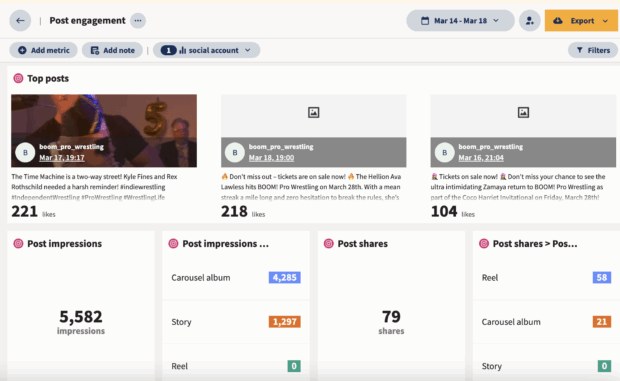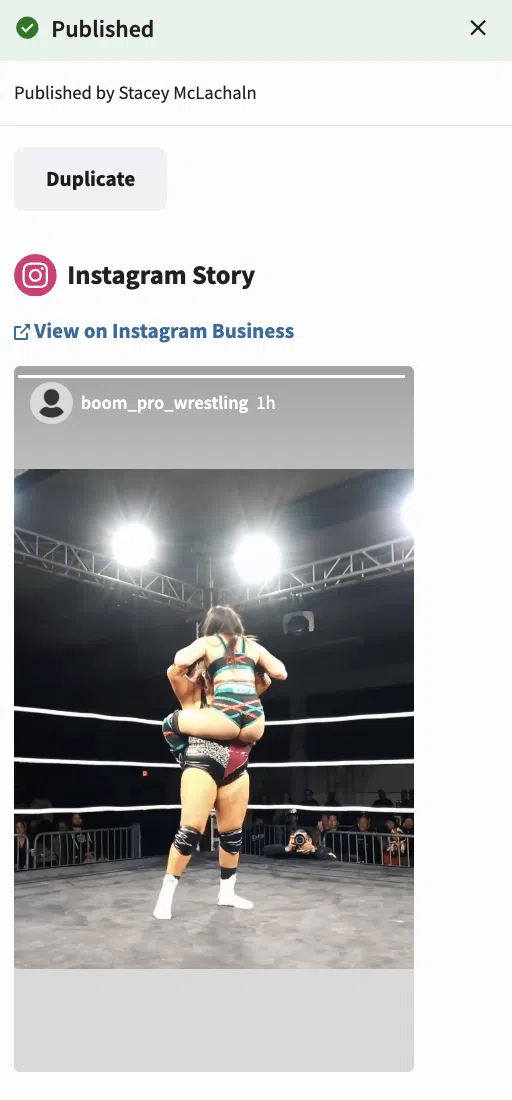For social media managers, it’s the last word city legend, handed down by means of whispers and unverified Reddit posts: Utilizing third-party scheduling instruments can tank your social engagement. Is a chill working down your backbone, or is it simply me?
It’s straightforward to see how a rumor like this might unfold. After spending hours perfecting your content material calendar and scheduling every thing by means of a instrument like Hootsuite, if you discover a submit underperforming, it’s solely pure to surprise, “Is it my content material, or the scheduling instrument’s fault?”
However is that this social media city legend really true, or is it simply one other conspiracy idea, like shadowbanning? Just one approach to discover out: it’s time to place this idea to the scientific take a look at.
Does utilizing third-party scheduling instruments really harm your efficiency on platforms like Instagram? We’re about to seek out out.
Speculation
Instagram posts scheduled by means of third-party instruments could have decrease attain and engagement than posts scheduled natively
Okay, this isn’t essentially our speculation, but it surely’s what the web has claimed, unsubstantiated, for years. We’re massive followers of the comfort of social media administration instruments just like the Hootsuite dashboard, so the rumor has been tough to listen to.
And look, perhaps it’s not very scientific to confess, however we actually hope it’s not true.
The speculation goes like this: Instagram (and different social media platforms) can inform if you’re posting by means of a third-party app and can punish you for not utilizing their native instruments by limiting how many individuals see your content material, primarily burying it within the algorithm.
If this idea is true, posts scheduled by means of exterior platforms ought to present decrease attain, impressions, and engagement (likes, feedback, shares, Story faucets, saves, and so on.) than these scheduled or posted manually inside Instagram.
As an organization that makes a scheduling instrument, it will be straightforward to simply dismiss this declare. However quite than ignore it outright, we determined to check it correctly.
Methodology
To check whether or not third-party social media scheduling instruments have an effect on efficiency, I wanted to design an experiment that might isolate this variable whereas maintaining every thing else as constant as potential. However as a sporadic private poster, my very own account wasn’t the perfect place to check this idea.
As a substitute, I requested my husband, the owner-operator of Vancouver’s Increase Professional Wrestling, if he would please let me use his enterprise account (@boom_pro_wrestling) as a case examine.
He kindly agreed. (Thanks, Max!)
After all, this experiment makes use of a wrestling enterprise account, however we’d argue that the findings apply to any trade, from retail to nonprofits.
Right here’s how I approached it:
Week 1: Posting and scheduling utilizing Instagram
Max posted 5 feed posts (a mixture of single pictures, carousels, and Reels) and 5 Instagram Tales straight by means of Instagram.
For instance, a retail model would possibly submit product photographs, whereas a nonprofit might share impression tales — our wrestling content material adopted the same promotional combine.
Max maintained his standard content material combine (clips from reveals, ticket sale bulletins, wrestling pictures), posting fashion, and hashtag technique. After posting, he recorded engagement and attain metrics for every submit.
We calculated the engagement price for every submit because the quantity of people that favored, commented on, or shared a photograph, carousel, or Reel divided by the submit’s attain (the quantity of people that noticed it).
Week 2: Scheduling utilizing Hootsuite
For the second week of the experiment, Max used a third-party instrument (on this case, Hootsuite) to schedule 5 extra feed posts and Tales.
The kind of content material was much like what he’d posted the week earlier than, with comparable themes, caption lengths, hashtag counts, and similar posting instances).
After all, we recorded all efficiency metrics once more. This was tremendous straightforward to do due to Hootsuite’s built-in analytics options, as you’ll see — and Hootsuite calculates engagement the identical manner we did, which makes the comparability even cleaner.
To make the take a look at as honest as potential, we:
Used the identical Instagram account for all posts
Posted across the similar time on corresponding days
Saved caption lengths and hashtag counts constant
Used comparable visible types and content material themes
Outcomes
Now for the second of fact: did we see a big distinction between content material posted natively versus content material scheduled by means of Hootsuite?
Right here’s what the info confirmed:
ENGAGEMENT RATETOTAL LIKESTOTAL COMMENTSTOTAL SHARESTOTAL REACH
Native Posts6.44percent336181097,189
Scheduled Posts8.19percent713377910,122
Bigger checks are wanted to verify traits, however for now, it appears to be like like we will put the rumors to relaxation. The numbers don’t lie: scheduled posts outperformed native posts in most metrics, together with engagement price.
The 1.75% enhance in engagement price for scheduled posts suggests a possible benefit, however with solely 5 posts per methodology, this distinction is probably not statistically vital.

What do the outcomes imply?
Our small-scale experiment means that third-party scheduling instruments like Hootsuite could not harm Instagram efficiency and will even provide advantages.
Our experiment confirmed that typically, scheduled posts really outperform native posts, suggesting that the Instagram algorithm doesn’t penalize content material based mostly on which publishing methodology you employ.

After all, that is a particularly restricted pattern dimension of knowledge, and third-party scheduling instruments could have a unique impression on a unique social media platform… however these are experiments for an additional day.
Outcomes could differ throughout platforms, instruments, or account varieties, so think about your distinctive context when selecting a scheduling methodology. And be happy to check it your self to verify!
For now, congratulations to all you social media managers who depend on scheduling instruments to take care of your sanity. You may proceed along with your batch content material creation and posting at the perfect time — carry on keepin’ on.
Why the scheduling methodology doesn’t matter
Instagram’s algorithm is designed to indicate customers content material they’re prone to interact with based mostly on their previous conduct and preferences. The algorithm cares about elements like:
The connection between poster and viewer (how typically they work together)
The timeliness of the submit
The engagement the submit has already obtained
The kind of content material (picture, video, Reel, and so on.)
Fortunately, how the submit was revealed seems to haven’t any bearing on these elements. The platform is in the end in search of to indicate related, participating content material to customers, not punish folks for utilizing time-saving instruments.

In reality, Instagram’s Graph API documentation reveals that third-party instruments can publish content material easily, with no point out of algorithmic penalties for utilizing these strategies. Our experiment helps this, suggesting that the publishing methodology doesn’t have an effect on algorithmic prioritization.
This probably applies to most third-party scheduling instruments, comparable to Buffer or Later, although we solely examined Hootsuite.
However why does the parable persist?
If third-party instruments don’t really harm efficiency (and, in line with our examine right here, may very well assist efficiency), why accomplish that many individuals imagine they do? Just a few potential explanations:
Correlation vs. causation. Maybe individuals who discover decrease engagement after switching to a scheduling instrument are experiencing different modifications concurrently (like shifts in content material high quality or posting frequency).
Outdated data. It’s potential that within the early days of the Instagram API, there have been limitations that affected how third-party posts carried out. These limitations (in the event that they ever existed) look like lengthy gone, however the myths dwell on.
Affirmation bias. When you imagine one thing would possibly harm your engagement, you’re extra prone to blame poor efficiency on that issue quite than contemplating different variables.
The character of social media algorithms. These algorithms change continuously, inflicting pure fluctuations in efficiency that folks would possibly wrongly attribute to their scheduling instruments.
When your alternative of instrument would possibly matter
Whereas our experiment confirmed that third-party scheduling instruments don’t harm submit efficiency, there are some conditions the place your publishing methodology might probably impression engagement on social:
New options. When platforms launch new options, they typically restrict entry to their API companions initially. For instance, when Instagram first launched Reels, you couldn’t submit them through third-party instruments. Throughout these durations, utilizing native posting for brand new options is important. (However you may schedule Reels on Hootsuite now, hooray!)
Technical glitches. Often, API modifications may cause momentary points with how third-party instruments work together with social platforms. These are often resolved shortly however would possibly briefly have an effect on how your content material seems.
Platform-specific optimizations. Some native options (like Instagram’s “Add Yours” sticker for Tales) are solely accessible when posting straight by means of the app.
The true elements that have an effect on your social media efficiency
As a substitute of worrying about whether or not scheduling instruments are hurting your attain, deal with these elements that really impression efficiency:
Content material high quality. Excessive-quality, related content material that resonates along with your viewers will at all times carry out higher, no matter the way it’s posted. Listed here are 40 concepts for if you’re feeling tapped out for creativity.
Viewers understanding. Figuring out what your followers wish to see and once they’re on-line issues way over your publishing instrument. Right here’s a information to discovering your audience.
Consistency. Common posting retains your viewers engaged and indicators to the algorithm that your account is energetic. Pssst: Scheduling your posts may help with that.
Pattern consciousness: Staying on prime of platform traits and embracing new options can provide your content material a lift. Time to get your social listening on!
Engagement along with your group: Responding to feedback and messages indicators to the algorithm that you simply’re fostering significant interactions. Take this webinar to degree up your group engagement abilities.
In conclusion
After concluding my official experiment, I can confidently say that utilizing third-party scheduling instruments like Hootsuite doesn’t seem to negatively impression your Instagram efficiency. What issues most is the standard of your content material and your understanding of your viewers.
So go forward and schedule these posts! Reclaim your weekends, plan your content material upfront, and cease worrying about whether or not the algorithm is punishing you for utilizing instruments that make your job simpler.
Enhance your Instagram engagement utilizing Hootsuite. Schedule and publish posts on to Instagram, interact your viewers, measure efficiency, and run all of your different social media profiles — all from one easy dashboard. Strive it free as we speak.



